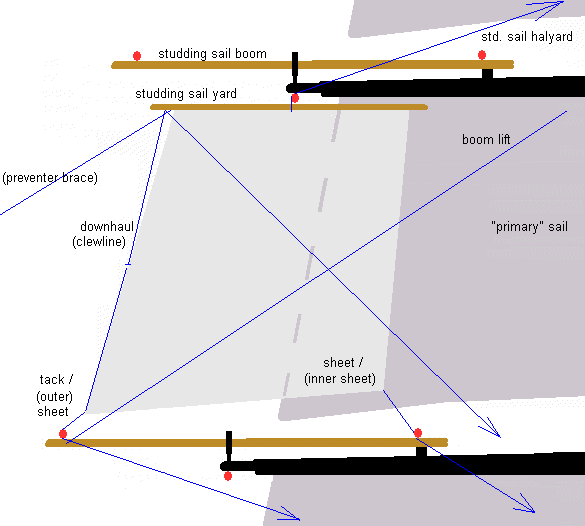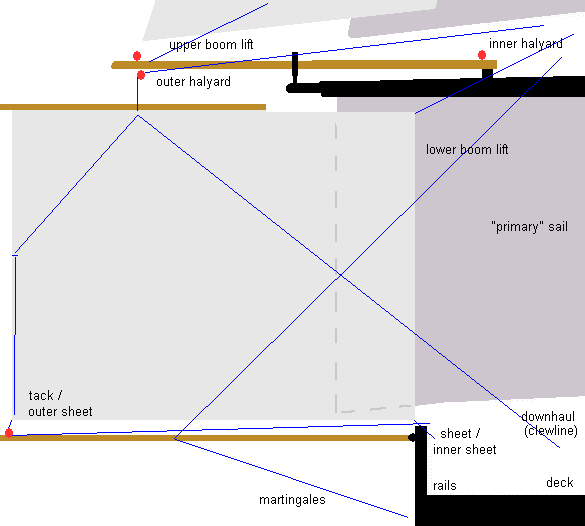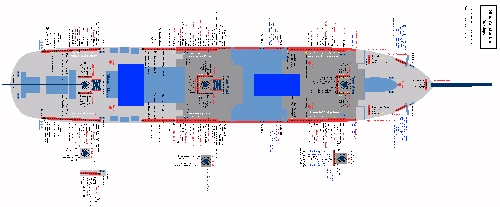Ship Modelling
Rigging Patterns - Stunsails = Studding Sails
This specific detail - I admit it became my favorite nut that is hard to crack - is neglected by most of all maritime researches, as it is really only a small detail,
of a sail that was rarely used - in calm weather only.
I became gradually ever more interested in this very question some 30 years ago, when I built my second clipper model, as a teenager. It was the Thermopylae 1:96 from Revell (later I figured out that it was a clone kit of their Cutty Sark of the same scale). It had NO studdingsails as I expected from the Cutty Sark, the first clipper I built before (in a smaller scale, 1:196). What made my interest growing on and on was just the very fact that there was almost nothing in the books about them. Well, that was a challenge! The cliché of the Cutty Sark with all canvas set including her stunsails was some kind of imprinting, as I read that all clippers, as well as all Ships of the Line had this "feature". The Themopylae model kit did not have them. But I already found pictures of her WITH stundails set, even if only some of them. Other depictions suggested that staunsails are set only exceptionally, we have not a single photo of the sailing Cutty Sark WITH stunsails set. Many drawings and paintings gave the same hints. So, when were stunsails applied? And if, how? HOW were they set, trimmed or furled? Q1: WHEN were stunsails used?
Well, definitely NOT like this!
Short answer: when there was light weather only, to catch all available winds.
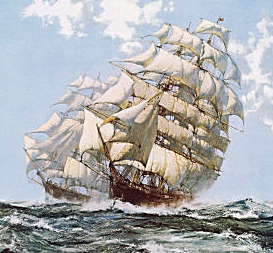 Montague Dawson´s famous painting "Taeping and Ariel race", made around 1950.
Very impressive indeed, but unlikely to be realistic:
Only very few books contain some explanations ... Dana´s book "Two Years before The Mast" was referred to by C. Nepean Longridge (in his "bible" about the Cutty Sark!) as an evidence that studding sails in fact had been set even on races around Cape Horn - and when I wrote the text for this page, I have to admit that I did miss that, but it is described nearly at the end of Danas book; Dr. Ottfried Thümmel sent me a mail, and he indeed found the chapter I was obviously missing, as I previously doupted it: but it was in chapter XXXIII (33), where Dana describes how a fore top stunsail (which side is not mentioned, but obviously only ONE side) has been added to the rigg, despite there was a gale, and the all hands on deck first thought that the captain was M-A-D ... but they carried out the orders. It was a hard work of one hour to set it at all in the strong wind - with ALL hands for ONE sail! -, and to secure it. The top stunsail boom was of special spruce wood that bowed under the enormous pressure without carrying away...the ship was then almost "flying" over the waves, giving the helmsmen a hard time! Then, they also added the lower fore stunsail, too (!), but that blew away short time after that. And for two days, the top stunsail was still up with the ordinary courses and reefed topsails, adding speed up to 11 knots for the ship, until the wind lessened eventually. It was also described that this new stunsail had a unique feature: a reef! It sounded like they had only this one for one side, as they speak of only one, which could be used on any side as needed. OK, this IS an evidence, thank You to correct me, Mr. Thümmel! I want to encourage anybody, if You have some comments, pls send them to me! BUT: I still think it was not common to use the stunsails in such a daring way. Some ships may have done so, but then only the clipper ships, but doing it like Montagues pictures suggests, it was right at the edge to hazard the entire rigging, and to get totally dismasted eventually. What I did not know for so long time: the rigging of studding sails is very complicated, and quite weak, too, even when secured with preventer braces and the like. It is much work, taking much time, to handle these sails at all - especially when a gale comes up, the sails must be furled as fast as possible, or they would just blow away and maybe also carry away the primary rigging - stunsails were only auxilary sails in light winds or in the steady trade winds. The single book giving explanation - by excellence! - is Harland & Myers "Seamanship in the Age of Sail". It contains a whole chapter about stunsail, covering all prior sources of maritime books. Another evidence I got from my two short voyages with the Swedish replica Götheborg III in 2009 and 2010: they told me that stunsails had been used once only ever: in a _calm_ in the Indian Ocean, sailing home to Sweden in 2007. And the belayings were really undefined, they had to use their phantasy and find a suitable place to belay... Now, of course, the replica Götheborg III is a precious ship, and their captains and masters are avoiding ANY risk to damage the rigging, also because the crew almost entirely consists of inexperienced trainees and volunteers (like I was), only with a small core crew, some of them from Norway. The old seamanship with its huge experience had gone long ago, and is gradually rediscovered today. Q2: HOW were stunsails rigged? → What are the elements of stunsails at all?As being said, the rigging of studding sails is very complicated, and quite weak, too. It is much work, taking much time, to handle these sails at all. These auxiliary sails were set from the deck, they were never left at the yards when furled. (At least, all sources indicate this).
A preventer brace may be set in stronger winds, as the sail yard swings almost loose around the jewel block, through which the single halyard led (the obvious solution - using two hayards - has never been applied for some reason ...). By doing so, the overlapping studding sail actually is a safety hazard by its design, because it can thus damage the primary sail! In stronger winds, the boom would need another preventer brace, in order not to break! But with more preventer braces, the bracing of the entire yard "arrangement" becomes more complicated, when You have 3, 4 or 6 braces per yard(!) and not just 2 for the primary yard. Many depictions show studding sails only on one side of the primary yards - mostly the weather side when braced sharp. Because a sail of no use (blanketed in slipstreams) would just be a waste of effort. When sailing large, it was suggested to set studding sails to the fore or main mast only, otherwise some stunsails would be blanketed in lee (other languages have the term "shadow of the wind").
Here is the (continental) pattern for the Running Rigging that was used on almost every 3-masted ship between 1700 and 1800: 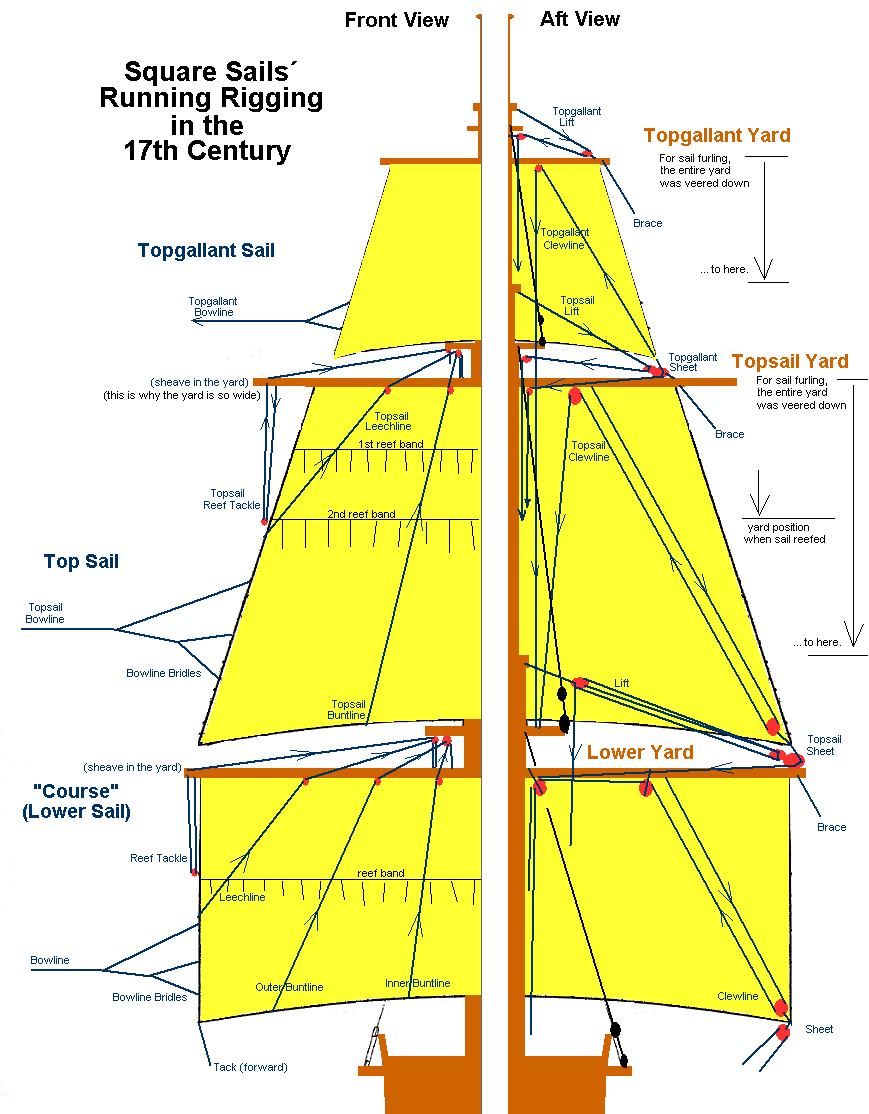
Auxiliary stunsails came up in this era, too: 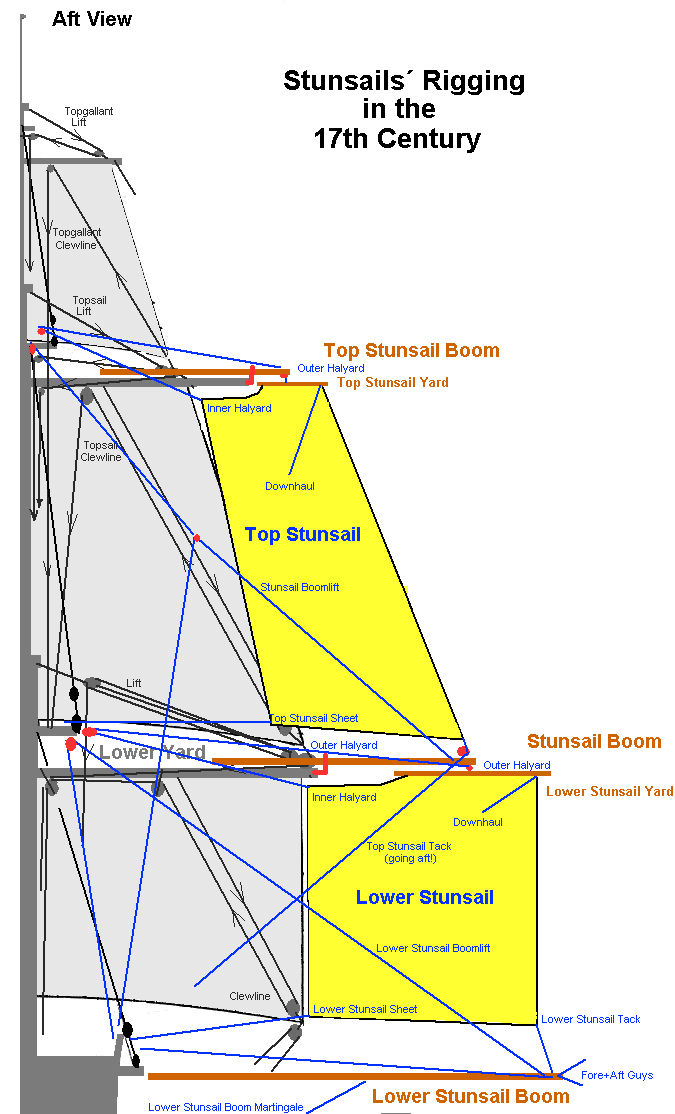
All this is not very stable! The entire wooden rigging is "moving in its gears", it is flexible by design. An incidental squall could mess the hole thing around...which did happen quite often: when the wind was too strong (and that is: the sails too weak - the stunsails are the weakest!), the ship was in danger to loose its entire rigging, and sink eventually because without stabilizing storm sails, the ship was lost in the choppy seas. So, for a captain of that time, it was a difficult decision, led by much experience only, how many sails could be set to make speed, *and* to return safely... and those captains how made it through all these odds at sea were admired like supermen. OK, back to details: an "average" square rigged mast with 3 sails already had about 20-30 lines coming down to deck to belay. Each single stunsail has 4 lines at least. Setting just 3 stunsails at one side adds 12-15 lines to the primary rigging. This doubles when set on both sides. There could be in fact more lines for all stunsails than for the primary rigging! Which leads to the problem: where were all those lines belayed? All pins at the rails and the bitts were occupied with the primary rigging. As far as research can tell, there were no dedicated belaying pins for stunsails that were set rather seldomly. So, anything in the shrouds or at the rails that could be used as a belaying place was used when it was possible. In the shrouds, more clamps could be added easily when needed. But also the dead eyes and other armours could be used for a knot. Many lines from the upper stunsail did not lead to deck, but were belayed somewhere in the tops. And there were double belayings: it was and is a bad practice in seamanship, but it was done so for convenience at all times. The problem here is: You could mix up lines which You must not, or You have at least to think about which line is "not moved" as long as stunsails are used ... thus, even occupied pins, e.g. for various lines of the lower sails not to be taken in soon, could be reused, for multifold belayings. UPDATE 2015-11-22: Sailing with the clipper ship "Stad Amsterdam" in October 2015 was the key experience for me to get answers for all details finally!
A big thanks to Kristina Jacobsen, quartermaster and master instructor for the crew! So here is a REAL belaying plan including all details for the stunsails: Q3: HOW were stunsails set?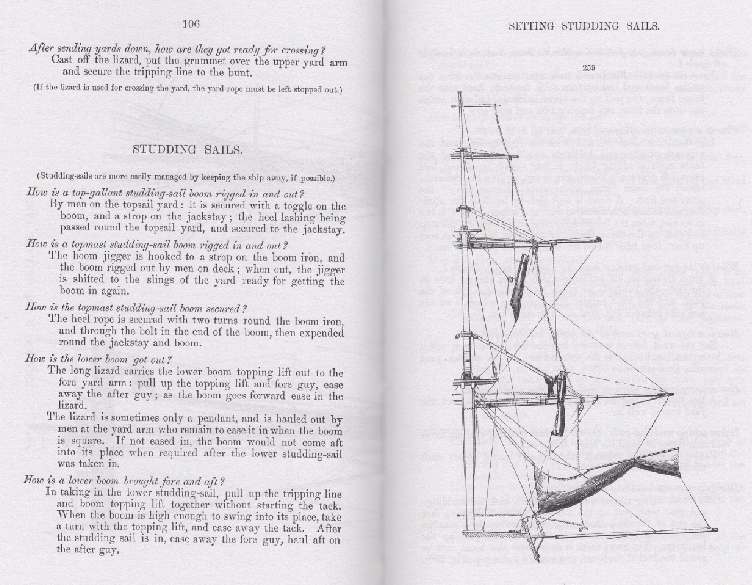
I think that Nares´ classic book "Seamanship" from 1862 is almost unknown today. Among many other contemprary authors, he is the one of the extremly few providing a picture: Generally there are two methods:
Onboard the Swedish replica East-Indiaman "Götheborg III" in 2005, on their way home from China, both methods were "re-invented", but applied only once in a calm in the Indic Ocean. An excellent book giving plenty of explanation is Harland & Myers´ "Seamanship in the Age of Sail". It contains a whole chapter about stunsail, covering all prior sources of maritime books. Astonishingly, the US rear admiral S.B. Luce in 1950 published his book Seamanship, containing some pages of detailed descriptions of handling these sails (pp.215-217 + 418-424. He also presents a similar picture to Nare.) By that time, not a single sailship in the world, except some experimantal replicas, ever used them at all. Q4: HOW were stunsails trimmed?According to the rigging of studding sails, they make all movements as "auxiliary or secondary" sails of the "primary" yard as they are attached to it. When bracing the yards, ALL the stunsail lines have to be trimmed again - lots of work and lots of lines to be mixed up!Q5: HOW were stunsails furled?They were taken down entirely, by their downhauls, when no longer needed. Halyard, sheets and tacks were eased carefully to prevent flagging. Then, the studding booms were taken in also.Some remarks about the stunsail booms on the yardsWhen in use, these booms were set out to the yard arms, but when not, the booms were fixed on top (or below) of the yards, only a small part was still "sticking out" beyond the yard arm. But THAT rises a problem for the sailors ...... when they go aloft on the yard to take in and bend the sails: the boom is in their way, making work more difficult, to lie down over the yard (upon their abdomen, that is), and to work on the sail just by standing in the footropes. The solution to this problem is shown in old depictions and books about seamanship: when the sail of the yard was to be bent, and stunsail were not used, both booms to port and starboard were partially lifted up so that the sailors could lie down on the yard as usual and drag the sail up which is very heavy work with traditional hemp canvas, especially to the center of the yard where the most of the canvas was stowed. A reader completely unaware about stunsail would just wonder what this strange diagonal booms had been ... The "Cutty Sark" and the "Stad Amsterdam" have their lower stunsail booms attached BELOW the yard! Yet again, that makes it difficult to throw the gasket back over the yard when bending the sails ... but in the end, if of course can be done. Q6: Stunsails todayFor a long time since the 1850s, stunsails were no longer used and regarded old fashioned, very difficult to handle, too fragile, in other words: a poor mess =)But in 2010, there ARE some rare modern sailing ships, and some replicas, that still can set stunsails. Those are, to my knowledge:
BooksHere are the few books I know, dealing with this detail question (I omit those that only "mention" them without details, e.g. the dictionaries ...):
|
.jpg)
